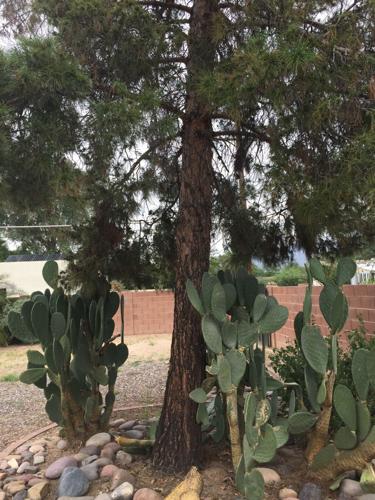Q: I was surprised to read your answer to the Green Valley lady who wanted to relocate lizards. I am the opposite of her: I would love to relocate some lizards from my office building area to my home, if I could catch them. I live in the northwest area of Tucson near the Tucson Mountain foothills and we do have a few lizards. I would like to know how to encourage them to stay and bring their friends.
Answer: The Arizona Native Plant Society has a brochure on its website that describes how to make your yard lizard friendly. You can also check the Tucson Herpetological Society website for more information on lizard species.
In short, providing a variety of plants and shelters for lizards should entice them to make homes in your landscape. Lizard-friendly plants can be trees, shrubs, cacti, and flowering plants that provide places to forage, bask, hibernate, and breed. Native plants such as prickly pear cactus, desert spoon, and cholla cactus work well for this purpose. Lizards need protection from predators like cats, dogs, and birds. A simple way to provide protection is by creating rock or log piles. These piles will give lizards places to bask and forage. If you build it, they will come.
Q: I have a navel orange tree in my yard and I noticed this year that as the oranges are getting ripe in many cases they are splitting in half and falling off the tree. Not sure why or what would cause this. Any feedback would be great.
A: Oranges often split due to uneven irrigation. We usually notice this after significant rain events. The trees are unaccustomed to a lot of water at once and the split fruit is the result. The way to mitigate this is to water the trees more deeply throughout the year so that large amounts are less of a shock to their system.
For citrus, the recommendation is to provide water every seven to 10 days in the summer to a depth of 36 inches. In the fall and spring you can adjust the timing to once every 10 to 14 days and in the winter once every 14 to 21 days. Using a drip irrigation system is best and the emitters should be arranged in a circular fashion near the drip line of the tree. Based on the size of your tree, four emitters would be sufficient.
Q: I have a mature palo verde tree in my back yard that has what appear to be some kind of white scale on the trunk and several main branches — it almost looks like cement or mortar. On some of the smaller limbs there are some blemishes that look like they might be eruptions in the bark. Happened to see a woodpecker working very hard on one of these areas yesterday. Tree seems to be losing some leaves. How do I save this tree?
A: There is a species of scale insect that infests palo verde trees, especially those in urban environments. In some cases, the scale population is so high that they completely cover the bark on parts of the tree. The appearance you described begins with small eruptions in the bark. I’ve seen many like this in downtown Tucson and on the University of Arizona campus.
While these insects will feed on sap and reduce the vigor of the trees, they aren’t likely the primary problem. Trees in urban areas surrounded by buildings and other hard surfaces are subject to more stress than the trees out in the open desert. Scale insects, like many other insects, seem to be attracted to stressed trees. So there are a couple things you can do. One is to take good care of your tree if you aren’t already properly irrigating and pruning. The second is you can treat the trunk where the scale insects reside. Typically, the recommendation for scale management is a horticultural oil spray when the immature scale insects, called crawlers, are moving about the tree. This usually happens in late winter once the weather warms sufficiently for them to reproduce. The exact timing depends on local microclimates but usually there is at least a two-week window. Keeping an eye on the situation with a magnifier should allow you to see when the immature scale insects are active. You might also find predator insects such as the twice-stabbed lady beetle feeding on these scale insects. That is why I recommend horticultural oil instead of something stronger.
Q: My pine tree is not doing well. I was wondering if pine beetles causing the problem.
A: I looked at your tree and I saw no sign of bark beetles. The signs to look for are red-boring dust on the bark, exit holes in the bark, and overall discoloration of the needles from green to a straw color. While your tree does show some dead needles, it doesn’t show the widespread discoloration typically seen on trees with beetle infestations. The tree appears to be too dry and I couldn’t tell if the soaker hose nearby is functioning or not. If not, that would be a good thing to fix and put on a schedule either manually or with a drip irrigation controller using the schedule describe above in the citrus question.






